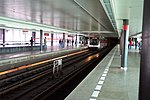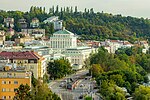Nusle Bridge
Bridges completed in 1973Bridges in PragueViaducts

Nusle Bridge (Czech: Nuselský most) is a prestressed concrete viaduct in Prague, Czech Republic. It connects Prague 2 and Prague 4, across a valley which forms part of the Nusle district. The bridge is one of the longest in the country and carries two footpaths, a multi-lane road and part of the city's rapid transit network. The bridge links the city center to its south-eastern districts such as Pankrác, and joins the D1 motorway leading to Brno. It is crucial to Prague's transportation network, since almost all north-south traffic flows across it. Below the six-lane highway on the surface, lies part of Prague Metro Line C between I.P. Pavlova and Vyšehrad stations.
Excerpt from the Wikipedia article Nusle Bridge (License: CC BY-SA 3.0, Authors, Images).Nusle Bridge
5. května, Prague Nusle
Geographical coordinates (GPS) Address External links Nearby Places Show on map
Geographical coordinates (GPS)
| Latitude | Longitude |
|---|---|
| N 50.065844 ° | E 14.430483 ° |
Address
Nuselský most
5. května
128 00 Prague, Nusle
Prague, Czechia
Open on Google Maps










